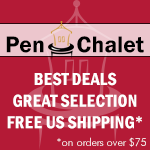One of the best parts about this job is there is no shortage of products to review. Whether it is a new release of a favorite Japanese gel pen or a new-to-me German pen brand, I love exploring, learning, and sharing what they are all about.
Cleo Skribent falls into the latter category. I had heard the name in passing, but had never tried one until my friend Renso at Papier Plume sent me one to check out.
Founded in 1945, this brand is everything you would expect from a respected German manufacturer. The designs are classic, the build is quality, and the performance is excellent.
The model I have on loan is the Cleo Skribent Classic Palladium, one of their entry level steel nib models. While it looks simple on the outside, it has a few added touches that make it a very enjoyable writer.
First of all, it is a piston filler. Hidden under a blind cap at the end of the barrel, the piston works smoothly and effectively. I had no issues drawing a full barrel of ink into the pen on my first go. And I have a soft spot for any pen with a full, clear ink window like this pen does.
Secondly, the nib is fantastic. I shouldn't be surprised given its German heritage, but wow, this steel nib sings. The model I'm testing is a Fine nib, and from the moment it hit the page it was smooth, clean, and had excellent flow.
Finally, the price. At $110 it is cheaper than the pen it compares most favorably to: The Pelikan M200 series. I think the piston mechanism in the Pelikan is better, likely because it might be the best in the world, but other than that, these pens are very comparable.
The Cleo Skribent Classic is longer than Pelikan's entry level model, and has a straight-taper section as opposed to Pelikan's lip at the end of the section. And, gun to my head and recency bias and all that, I think I prefer the Cleo steel nib.
Even though the comparison is made most easily to Pelikan, there is one thought I couldn't get out of my head the entire time I held this pen: This is a bigger, awesomer Pilot Prera. The Prera XL if you will.
If you have ever used a Prera, you will understand what I am about to say. It is an airy pen to write with. Lightweight, but somehow rock solid. That's why it is so well loved. The Cleo Skribent Classic feels the same way to me, except in a larger size and with a better filling system. If this pen were stamped Pilot at this price point we would all be having puppies over it.
Consider me a fan of Cleo Skribent. I'd like to try a few of their other models, especially in the brighter barrel colors they offer. The Classic has been an excellent introduction.
My thanks to Papier Plume for loaning me this pen for purposes of this review.
Enjoy reading The Pen Addict? Then consider becoming a member to receive additional weekly content, giveaways, and discounts in The Pen Addict shop. Plus, you support me and the site directly, which I am very grateful for.
Membership starts at just $5/month, with a discounted annual option available. To find out more about membership click here and join us!



































